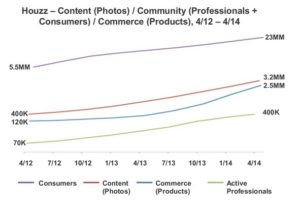houzz

You can thank this platform when you own your first home.
Introduction. As second-year HBS students, most of us have little interest in a home services platform – but after graduation, as we pursue new jobs, get married, buy homes, and eventually “grow up,” many of us will wish we had paid more attention to that “TEM” case on Angie’s List. When we decide to undertake that first kitchen remodel or build our first home, we will not crack the yellow pages like our parents did. Instead, we will seek the advice of platforms like Angie’s List, HomeAdvisor, Porch, and Houzz. Houzz, a late mover in this market, has quickly carved out a sizeable niche as a $4 billion platform that is part-Angie’s List, part-Pinterest, part-Amazon.[1]
Value Creation. Houzz was founded in 2009, over fourteen years after Angie’s List, but now boasts 40+ million unique users each month.[2] So how does a late entrant take over a first mover? Three words: “content, community, and commerce.”[3] Where some businesses grow from product or service centric models into platforms, Houzz first began as a network to share content, in the process built a community, and after creating value for users, only then moved to capture some of that value. (See Figure A)
Figure A. Houzz Growth, 2012 – 2014 (2015-present not available).
Houzz does more than serve as a matchmaker between homeowners and service providers. Inspired by their own home remodeling and design frustrations, the founders of Houzz created a free platform that allows architects, designers, interior decorators, landscapers, and other contractors to display their work (content creation) while homeowners can “dance through hundreds of photos in search of the [designs,] furniture and fixtures that will inspire their remodeling projects” (content consumption).[4] [5] (See Figure B)
Figure B. Example of Houzz user generated content for kitchens.
Houzz is the beneficiary of some serious network effects. Consumers while delighting in millions of beautiful and inspiring photos recommended to them by Houzz’s backside analytics, are also provided with contact information and reviews of local service providers free of charge.[6] As a result, more homeowners attract more contractors and more contractors create more content which attracts more homeowners who also contribute new content.
The founders also aggressively pursued “localizing” its landing pages to 15+ countries “to accelerate the global flow of design ideas” and in turn leverage some global network effects.[7] While a homeowner in the United States may not be able to hire the German contractor who posted pictures of a beautiful kitchen remodel in Munich, this content still increases the value for the entire Houzz network. Furthermore, the American homeowner in love with the German kitchen he or she saw on Houzz may choose to complete the remodel with a local contractor listed on Houzz.
(Note: Houzz’s network also grew into a community where users can share tips, hacks, and other advice, but this piece will not address that characteristic.)
Value Capture. Many platforms similar to Houzz start out by charging membership fees or exacting commissions on matchmaking. Houzz, on the other hand, deliberately chose not to capture any value during its first several years.[8] The founders said “no” to ads, commissions, and other revenue models early on to focus on “making Houzz the friendliest, smoothest site possible.”[9] This lack of value capture by Houzz gave all the value to its users, lowered the “cost-to-try,” and helped accelerate Houzz’s user growth.
After a few years of creating a free network that dwarfed Angie’s List, Houzz began to thoughtfully capture some of the value it had worked so tirelessly to create. Today Houzz generates revenue in the following three ways:
- Premium Memberships: Instead of charging commissions or fees to connect homeowners with service providers which can easily be disintermediated, Houzz still lets both parties join the network and connect with each other for free. Service providers can buy premium memberships which elevates their listings to homeowners and provides traffic analysis.[10]
- Ad Revenue: Houzz does sell adds to relevant vendors and manufacturers such as Lowes, Kohler, and Behr, but the ads are minimally invasive to the user experience.[11]
- Exchange Fees: In 2014, Houzz launched an online marketplace with 6+ million products from over 15,000 vendors.[12] In doing so, Houzz created a third network effect where homeowners, service providers, and vendors all contribute to a virtuous cycle. Houzz’s large existing network of homeowners and service providers allowed Houzz to rapidly attract vendors and simultaneously capture a 15% commission for items purchased on the site.[13]
Today, Houzz’s online marketplace uses artificial intelligence called “Visual Match,” that uses deep learning to tag objects (such as sinks, tables, and artwork) in pictures posted by users. The green tags become links to similar or recommended products in Houzz’s online retail store. Such features create additional value through “click-to-buy” convenience for homeowners and enhance the value of products for vendors by associating them with aspirational pictures of remodels.[14] (See Figure C)
Figure C. Houzz “click-to-buy” green tags.

Competition. On one hand Houzz is direct competitor to the likes of Angie’s List and HomeAdvisor, yet it isn’t. In theory, a homeowner could find inspiration on Houzz and then go to HomeAdvisor to find a contractor (which charges contractors a fee for every lead they receive), but this is not an issue since Houzz’s value capture does not depend on transactions being completed on its website. Furthermore, HomeAdvisor does not have inspirational content like Houzz – this content makes it more likely that a homeowner’s project will begin with Houzz and the “one-stop-shop” nature of the platform makes it more likely that he or she will complete the project with a service provider found on Houzz.
Given the multiple faces of the Houzz platform, both Wayfair (an interior decorating ecommerce site) and Pinterest (an idea discovery social network) could also be considered competitors. While Houzz is seemingly a platform where you can do everything, it is also very focused on the home improvement market, strongly associating the Houzz brand with home inspiration. Unlike Houzz, Wayfair does not provide homeowners with an enormous library of content and Pinterest does not connect users with reviewed service providers.
Conclusion. Some day you will move out of the city, give up your high-rise apartment, and settle down in the suburbs. And when you do, Houzz and its growing network of reviewed service providers, accessible vendors, inspirational content, and homeowners just like you will be there for you.





Love the post and a fresh view on the housing decoration solution! Out of curiosity I went and tested the platform myself and it is truly smooth and consumer-friendly experience. I love their little innovation ideas like tagging things to buy on the picture, that increases monetization aspect and helps differentiate against rising competition. My question is: did Houzz manage to build barriers high enough to avoid other players copying its features? Beyond design and features exposed to copying, I am also concerned whether the suppliers are multi-homing. What would prevent them from having their profile on multiple sites? In summary, looks like a really fresh and great idea, but they need to keep pushing their innovation pace to keep growing market share.
Thanks for the great post! My concern is about monetization – how can Houzz continue to grow revenues without making the site less friendly? I would like to see them explore native advertising – hopefully suppliers would be willing to pay for advertisements that flow seamlessly with the site and are helpful to users. Also, they could charge a fee for referrals from one of the green tags to a similar product, if the user bought the ultimate product. Either way, their growth is impressive!